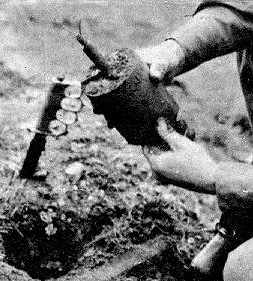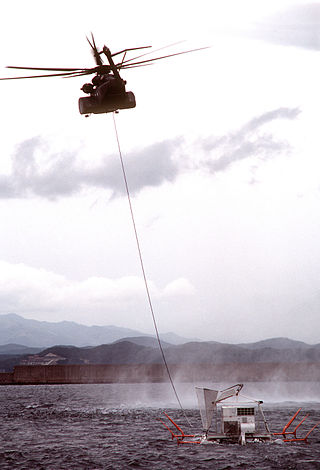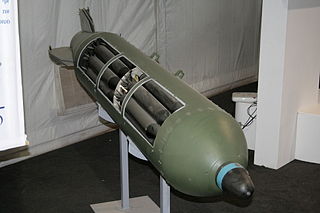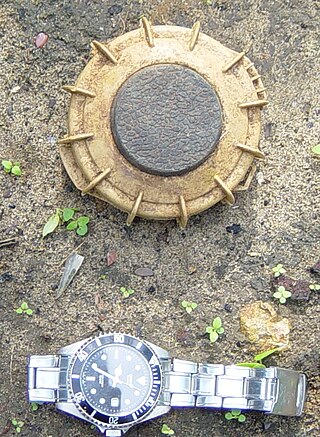
A bomb is an explosive weapon that uses the exothermic reaction of an explosive material to provide an extremely sudden and violent release of energy. Detonations inflict damage principally through ground- and atmosphere-transmitted mechanical stress, the impact and penetration of pressure-driven projectiles, pressure damage, and explosion-generated effects. Bombs have been utilized since the 11th century starting in East Asia.
The GATOR mine system is a United States military system of air-dropped anti-tank and anti-personnel mines developed in the 1980s to be compatible with existing cluster dispensers. It is used with two dispenser systems—the Navy 230 kg (500 lb) CBU-78/B and the Air Force 450 kg (1,000 lb) CBU-89/B. Additionally the mines are used with the land- and helicopter-based Volcano mine system.

A shell, in a modern military context, is a projectile whose payload contains an explosive, incendiary, or other chemical filling. Originally it was called a bombshell, contrasting with solid shells used for early rifled artillery, but "shell" has come to be unambiguous in a military context. A shell can hold a tracer.

In anti-tank warfare, an anti-tank mine is a type of land mine designed to damage or destroy vehicles including tanks and armored fighting vehicles.

The German S-mine, known by enemy Allied Forces as the "Bouncing Betty" on the Western Front and "frog-mine" on the Eastern Front, is the best-known version of a class of mines known as bounding mines. When triggered, these mines are launched into the air and then detonated at about one metre (3 ft) from the ground. The explosion projects a lethal spray of shrapnel in all directions. The S-mine was an anti-personnel mine developed by Germany in the 1930s and used extensively by German forces during World War II. It was designed to be used in open areas against unshielded infantry. Two versions were produced, designated by the year of their first production: the SMi-35 and SMi-44. There are only minor differences between the two models.

Minesweeping is the practice of removing explosive naval mines, usually by a specially designed ship called a minesweeper using various measures to either capture or detonate the mines, but sometimes also with an aircraft made for that purpose. Minesweeping has been practiced since the advent of naval mining in 1855 during the Crimean War. The first minesweepers date to that war and consisted of British rowboats trailing grapnels to snag the mines.

Anti-runway penetration bombs are explosive weapons involving bombs or bomblets designed to damage or destroy runways, or otherwise render them unusable for aircraft.

The Durandal is an anti-runway penetration bomb developed by the French company Matra, designed to destroy airport runways and exported to several countries. A simple crater in a runway could be filled in without issue, so the Durandal uses two explosions to displace the concrete slabs of a runway, thus making the damage to the runway far more difficult to repair. The bomb is named after a mythical medieval French sword.

The JP233, originally known as the Low-Altitude Airfield Attack System (LAAAS), is a British submunition delivery system. It consists of large dispenser pods carrying several hundred submunitions designed to attack runways.
The FGM-172 SRAW, also known as the Predator SRAW, was a lightweight, close range missile system produced by Lockheed Martin, developed by Lockheed Martin and Israel Military Industries. It is designed to complement the FGM-148 Javelin anti-tank missile. The Predator had a longer range and was more powerful than the AT4 that it was designed to replace, but had a shorter range than the Javelin.

An anti-personnel mine or anti-personnel landmine (APL) is a form of mine designed for use against humans, as opposed to an anti-tank mine, which target vehicles. APLs are classified into: blast mines and fragmentation mines; the latter may or may not be a bounding mine.
The M7 is a small, metal-cased United States anti-tank blast mine that was used during the Second World War. It was based on the British Hawkins grenade. Approximately 2.5 million were produced before production ceased, and although it has long since been withdrawn from U.S. service, it can be found in Angola, Burma, Cambodia, Chad, Eritrea, Ethiopia, Korea, Lebanon, Myanmar, Somalia, Thailand, and Zambia.
The AUPS is a circular Italian bakelite cased minimum metal anti-personnel blast mine. The mine can be adapted with a steel fragmentation jacket and stake into a fragmentation stake mine. The mine is constructed in two halves, with the upper half containing the pressure fuse mechanism, the lower half contains the main charge and the detonator. The mine case is normally unpainted bakelite brown.
The 4AHM-100, AHM-200, AHM-200-1, AHM-200-2, PMN-150, and PMN-250 are Bulgarian directional fragmentation mines that can be used with proximity fuzes to function as anti-helicopter mines.
The ATM-6 and ATM-7 are Austrian off-route anti-tank mines that use Misznay Schardin effect warheads to fire self forging fragments into the sides of armoured vehicles. Both mines are mounted on a pedestal base which is used to aim the mine, and have simple sights to aim the mines. The mines originally could be triggered by a variety of means, including contact wire and infra-red fuses, however as a result of Austrian laws, they now only use command detonation.

An anti-handling device is an attachment to or an integral part of a landmine or other munition such as some fuze types found in general-purpose air-dropped bombs, cluster bombs and sea mines. It is designed to prevent tampering or disabling, or to target bomb disposal personnel. When the protected device is disturbed, it detonates, killing or injuring anyone within the blast area. There is a strong functional overlap of booby traps and anti-handling devices.

The FFV 028 is a series of steel cased Swedish anti-tank mines that use electronic fuzes. The mines are circular, with a large Misznay Schardin effect warhead in the center of the mine, with the fuzing and sensor electronics located in the dead space above the main charge. The design of the mine dates from the 1970s and uses a magnetic influence sensor to detonate the mine, making it able to attack the full width of armoured vehicles.

Selectable Lightweight Attack Munition or is a small United States multi-purpose landmine produced by ATK Precision Fuze Company in Janesville, Wisconsin from 1992 to 2002. It has a passive infrared sensor, and a magnetic influence sensor which allow it to be used as a demolition munition, off-route mine, or full width belly attack mine.
In military munitions, a fuze is the part of the device that initiates its function. In some applications, such as torpedoes, a fuze may be identified by function as the exploder. The relative complexity of even the earliest fuze designs can be seen in cutaway diagrams.

KMGU is a Soviet munitions dispenser similar to the British JP233 and the German MW-1. It can be carried by most Soviet and Russian attack aircraft, including the MiG-23, the MiG-27, the MiG-29, the Su-22, the Su-24, the Su-25, the Su-27, the Su-30, and the Su-34 and the Mi-24, Ka-50 and the Ka-52 attack helicopter. The cylindrical aluminum fuselage is divided into 8 sections, each has its own pneumatically opened doors. It can be filled with:













